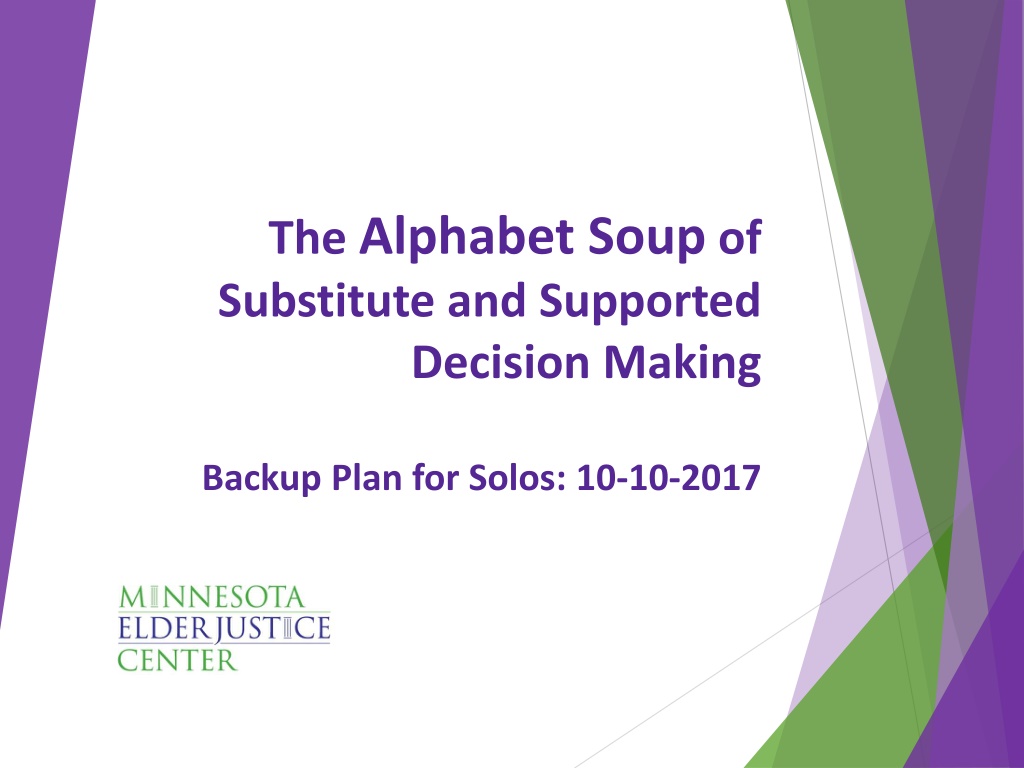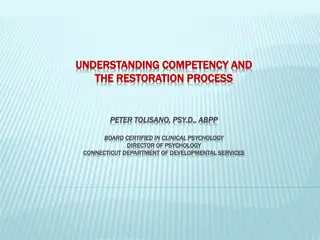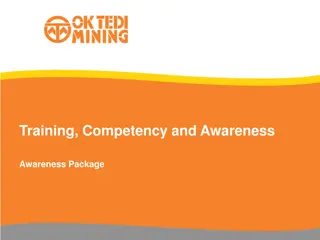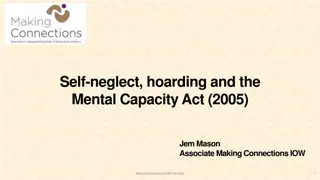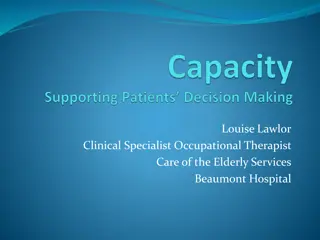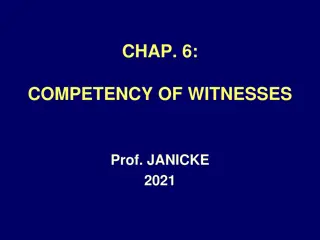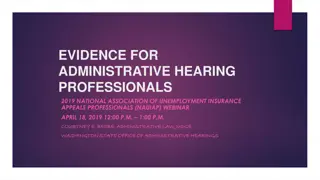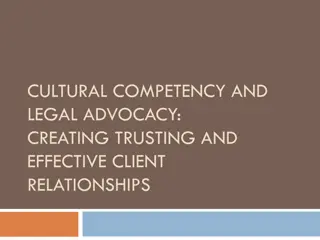Understanding Capacity and Competency in Decision Making
Exploring the nuances of capacity and competency in decision making, this content delves into the definitions, differences, and implications of these terms. It highlights the varying degrees of capacity required for different purposes and provides insights into substitute decision making and the plethora of acronyms involved in this realm. Additionally, it discusses civil legal responses to financial exploitation and civil protection orders. The content emphasizes the complexity and importance of understanding individuals' abilities in decision making processes.
Download Presentation

Please find below an Image/Link to download the presentation.
The content on the website is provided AS IS for your information and personal use only. It may not be sold, licensed, or shared on other websites without obtaining consent from the author. Download presentation by click this link. If you encounter any issues during the download, it is possible that the publisher has removed the file from their server.
E N D
Presentation Transcript
The Alphabet Soup of Substitute and Supported Decision Making Backup Plan for Solos: 10-10-2017
Defining Capacity Popular definitions hinge on an individual s ability or power. Capacity is the ability or power to Do something; Feel something; Understand something; Or some combination of those abilities.
A remark on Competency vs. Capacity Capacity and Competency are similar words, but they have very different implications. Capacity is the ability or power to make decisions; understand; think; feel; do. Competency is a legal determination (finding) decided by a court. For more on this, see: https://www.iowaaging.gov/capacity-vs-competency. Specifically applicable in Iowa but with general applicability in Minnesota as well.
Shades of gray Capacity is not black and white; not either/or; not all or nothing; not yes or no. Capacity looks different for different people Capacity can even look different for the same person at different times. Can be thought of as a continuum.
Varying Degrees of Capacity And, varying degrees of capacity are required for various purposes: Personal objectives; Legal responsibilities; Health and safety; Employment goals and requirements; Etc.
Varying Degrees of Capacity Similarly, in the legal realm, the capacity required to execute one type of document differs from the capacity required to execute another type. Contractual capacity Testamentary capacity Capacity to execute a Health Care Directive
Acronyms Everywhere! OFP AND HRO VA POA RP HCD PR POLST TTEE DNR PRACTICAL DNI GUARD/CON DNH And on and on and on
Civil Legal Responses to Fin. Exp. Civil suit (under variety of circumstances) Civil Protection Orders: OFP/HRO http://www.mncourts.gov/mncourtsgov/media/fourth_distric t/documents/OFP_v_HRO_Information_Sheet.pdf Understand individual expectations, particularly regarding contact with family members or caregivers
Civil Legal Responses Advance planning: estate planning; incapacity planning; nominations of fiduciaries and health care decision makers; assignments of authority in advance directives Supported Decision Making (SDM) http://supporteddecisionmaking.org/ Guardianship/Conservatorship action
What is a Fiduciary? A Fiduciary is someone who manages money or property for someone else. A Fiduciary has four basic duties: To act only in the best interest of the person he or she is helping. To manage the other person s money or property carefully. To keep the other person s money or property separate from his or her own. And to keep good records.
What is an Advance Directive? An Advance Directive is a document that: Legally identifies another person to make a decision for you whether or not (depending upon the document) you re able to make a decision for yourself And/or provides some instruction for that other person regarding your wishes
Types of Advance Directives Financial Directives (assignments of authority creating Fiduciary relationship) Trust Power of Attorney (POA) Statutory Short Form General Durable Other Financial Arrangements: Rep Payee VA Fiduciary Nomination of Guardian (under some circumstances) MA Authorized Representative
Types of Advance Directives Health Care Directives Minnesota Health Care Directive (HCD) Living Will Power of Attorney for Health Care Nomination of Guardian POLST DNR/DNI/DNH
Why would a person want to have an Advance Directive? To assert her or his wishes in the event she or he is not able to communicate To provide clarity for family members or friends To authoritatively identify who will be in charge or a decision-maker in absence of principal
Power of Attorney Legal document that gives permission for another person (people) to conduct financial business on your behalf. You: Principal Other(s) (Fiduciaries) identified as Attorneys In Fact
Power of Attorney Two types of Power of Attorney documents in Minnesota: General (or Common Law) Statutory Short Form MN Stat. 523.23
Power of Attorney Statutory Short Form Power of Attorney Four Sections: Powers Durability Gifting Accounting
Power of Attorney Properly Executed Statutory Form Signed or acknowledged in front of Notary Initialed Special Notice Note: specimen signatures and acknowledgement signatures NOT notarized Note: no expiration date required
Termination of Durable Power Durable Power of Attorney terminates on the earliest to occur of: The death of the principal The expiration date specified in the document Or in the case of a spouse as an attorney in fact; the commencement of separation, dissolution or annulment proceedings
Revocation of Power of Attorney An executed POA may be revoked by a written revocation signed by the principal (or on behalf of principal by another, f.ex. a guardian) and acknowledged by a notary public.
Health Care Directive Minnesota Statute 145C is the Minnesota Health Care Directive You can view a sample form there, or at the Minnesota Attorney General s Website: http://www.ag.state.mn.us/pdf/consumer/ healtcaredir.pdf
Health Care Directive Names a person (or people) to make a health care decision on your behalf if you are not able to make a decision Unification of two prior documents: Living Will Power of Attorney for Healthcare
Health Care Directive Best documents contain both elements Nomination of substitute decision maker Instructions regarding interventions Opportunity to articulate preferences with regard to intervention; but also Organ donation Burial or cremation Other desires/preferences
Health Care Directive Proper execution requires: Signature in front of a notary Or two disinterested witnesses Either nomination of proxy, provision of intervention instructions or both
Health Care Directive Considerations: Multiple decision makers agreement? Clarity of instructions give conversational guidance Change in perspectives over time remember, this is a living document Coordinate other documents with Health Care Directive (DNR/DNI/DNH; POLST)
Health Care Directive Revocation: A Health Care Directive may be revoked by: Preparing a written statement saying it is revoked or cancelled Destroying it (remember multiple copies) Telling at least two other people it has been revoked Writing a new Health Care Directive
Keep this distinction in mind: While the authority of the Health Care Agent is triggered by the incapacity of the principal person under a Health Care Directive; the Attorney In Fact is empowered to act as soon as the Power of Attorney document is executed (even if the principal person retains capacity).
POLST Provider Order for Life Sustaining Treatment Type of Health specific advance directive Completed by provider with patient Ideal under specific circumstances terminal condition; end-of-life
What is a guardianship? Relationship between an incapacitated person, the ward, and a person who helps the ward, the guardian Guardian: a person who has qualified as a guardian of a minor or incapacitated person pursuant to appointment by a parent or spouse, or by the court, and includes a limited, emergency, or temporary substitute guardian but not a guardian ad litem Types: Guardian of a minor Guardian of an incapacitated person
What is a conservatorship? Relationship between individual who cannot manage his/her own financial affairs, the protected person, and an individual helping the protected person, the conservator. Conservator: a person who is appointed by a court to manage the estate of a protected person, and includes a limited conservator Types: Unlimited conservatorship Limited conservatorship Other Protective Order
MN Statute: Uniform Guardianship and Protective Proceedings Act: Minnesota Statutes 524.5-101 through 524.5-903 Bill of Rights for Wards or Protected Persons: 524.5-120
Requirements in Imposition: Must be reason to believe that the person is incapacitated Diagnosis which may indicate incapacity is not enough Must be evidence which supports the belief, i.e. behavior which demonstrates incapacity
Statutory Definition of Incapacity in 524.5-102 An individual who, for reasons other than being a minor, is impaired to the extent of lacking sufficient understanding or capacity to make or communicate responsible personal decisions, and who has demonstrated deficits in behavior which evidence an inability to meet personal needs for medical care, nutrition, clothing, shelter, or safety, even with appropriate technological assistance.
Risks In Imposing Guardianship and/or Conservatorship Imposition on Ward/Protected Person s civil rights and autonomy Must be no less restrictive alternatives POA, HCD, trustee, other fiduciary Supported Decision Making
Powers and Duties of Guardians and Conservators Guardians and Conservators subject to control and direction of court at all time Court shall grant only those powers necessary to provide for demonstrated needs of the ward or protected person Court can terminate; called restoration
What is a Representative Payee or a VA Fidcuciary? These are roles appointed by government agencies to help manage income benefits for another person. Social Security, Railroad Retirement, and the Office of Personnel Management appoint Representative Payees. The Department of Veterans Affairs appoints VA fiduciaries.
What authority does the Representative Payee or VA Fiduciary have? The Rep Payee or VA fiduciary manages only the benefits of the appointing agency. The ability to control other matters such as any other property, account, asset, or health matter results out of legal authority from some other source (a POA, trust, or court appointment).
VA and Rep Payee Reporting Requirements Rep Payee annual reporting forms are available form Social Security. If a person is receiving SSI, additional reporting is required. VA fiduciaries must submit accountings when asked for them forms are available from Veterans Affairs. Agencies require notification regarding changes of circumstance for the recipient and for the fiduciary.
What is a Trustee? A trustee is a person who makes decisions about the money or property in a trust. There can be one trustee, or more than one (co-trustees). A successor trustee is a person who acts when the initial trustee can no longer make decisions.
What property does a trustee manage? A trustee has authority only over property actually transferred into a trust. A trustee does not have legal authority over property that exists outside the trust. To assert decisions over other property, some other grant of authority is required.
Other Roles within a Trust The person who makes the trust may be called the settlor, grantor, or trustor. The person who receives money or property from the trust is called the beneficiary. There may be one beneficiary, or more than one (co- beneficiaries).
Trustee roles and responsibilities Roles and responsibilities of trustees include basic fiduciary duties, as well as many other specific responsibilities as defined by the language of the trust document itself. You must review the trust document to understand a trustees responsibilities.
What is Supported Decision Making? Supported Decision Making (SDM) is a philosophy that acknowledges that people are happier and safer when exercising the most autonomy of which they re capable. It s an approach that maximizes individual agency, and minimizes external decision-making whenever possible.
PRACTICAL Tool P: Presume guardianship is not needed. R: Reason i.d. reasons for concern A: Ask if concern is caused by temporary condition C: Community look at community resources and accommodations T: Team ask the person whether she has already created a team to help I: Identify abilities areas of strength and need in decision-making C: Challenges identify any challenges posed A: Appoint appropriate legal supporter or surrogate L : Limit any necessary guardianship petition or order - ABA Commission on Law and Aging
Civil Legal Responses or Tools Agency involvement/Administrative action: CMS (Medicare/Medicaid) Social Security (Rep Payee) Veteran s Administration (VA Fiduciary) DHS and MDH (re. licensure matters, among other reports) Other civil legal responses?
Additional MN Statutes Vulnerable Adult: Minn. Stat. 626.5572 Categorical and Functional Definitions Inpatient at a Facility Receives services at or from a facility Receives services from a home care provider, or person that acts as a personal care/medical assistant Possesses a physical, mental, or emotional infirmity/dysfunction
Additional MN Statutes Financial Exploitation: Minn. Stat. 609.2335 Breach of fiduciary duty - ie Power of Attorney Use of property for something other than the benefit of the vulnerable adult Fails to use property for benefit for vulnerable adult Deprives vulnerable adult of financial resources
The Minnesota Adult Abuse Reporting Center Began receiving reports on July 1st, 2015. Single toll-free number: 844-880-1574 Available 24 hours per day Immediately notifies county agency (EPS); law enforcement (crime); Med Ex, Ombudsman for MH (suspicious death) Refers directly to Lead Investigative Agency Online reporting for mandatory reporters Feeback to: dhs.adultprotection@state.mn.us
